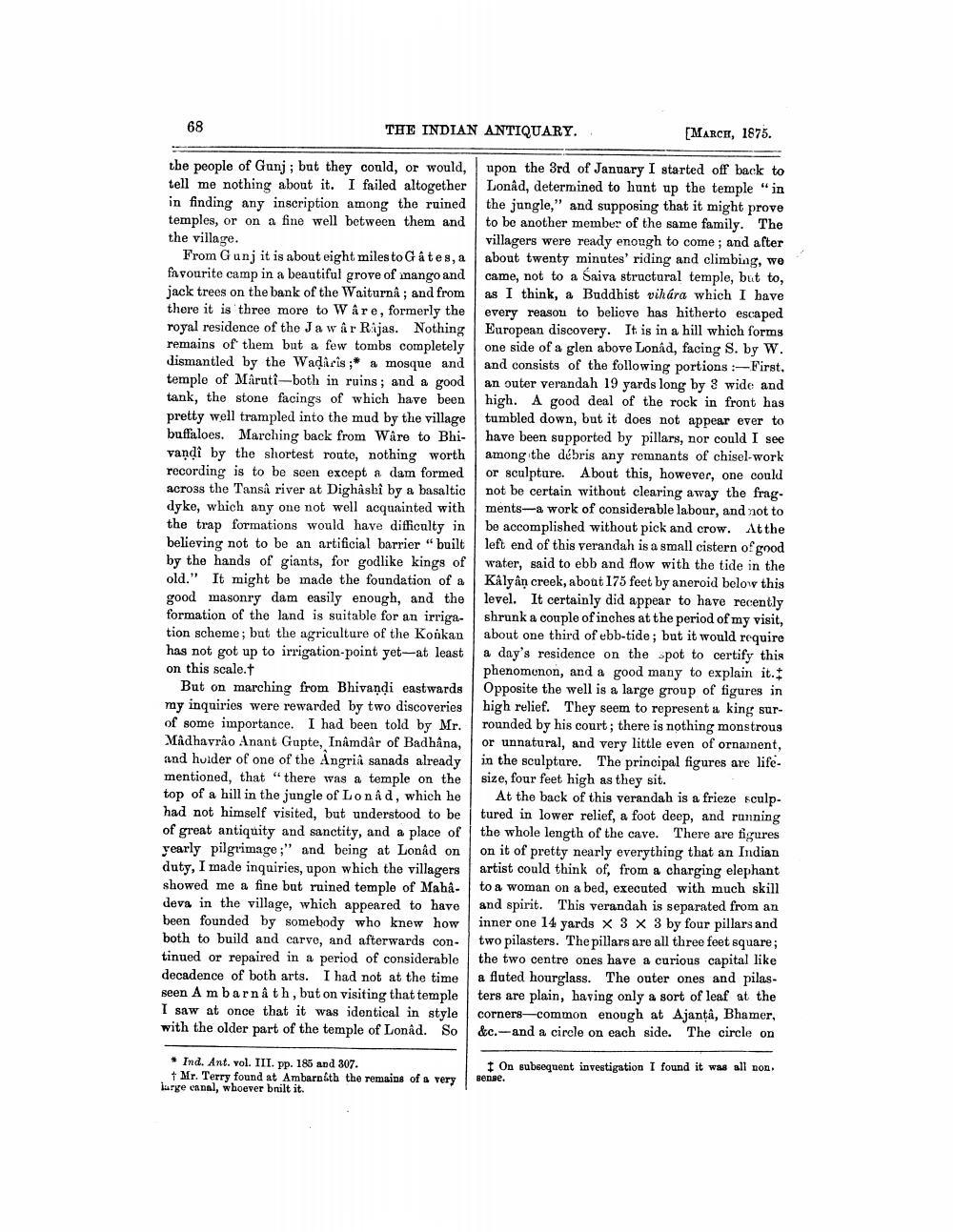________________
THE INDIAN ANTIQUARY.
[MARCH, 1875.
the people of Gunj; but they could, or would, tell me nothing about it. I failed altogether in finding any inscription among the ruined temples, or on a fine well between them and the village.
From Gunj it is about eight miles to Gates, a fnvourite camp in a beautiful grove of mango and jack trees on the bank of the Waiturnâ ; and from there it is three more to Ware, formerly the royal residence of the Ja war Rijas. Nothing remains of them but a few tombs completely dismantled by the Wadicis ;* a mosque and temple of Mârutî-both in ruins; and a good tank, the stone facings of which have been pretty well trampled into the mud by the village buffaloes. Marching back from Ware to Bhivandi by the shortest route, nothing worth recording is to be seen except a dam formed across the Tansâ river at Dighashî by a basaltic dyke, which any one not well acquainted with the trap formations would have difficulty in believing not to be an artificial barrier " built by the hands of giants, for godlike kings of old." It might be made the foundation of a good masonry dam easily enough, and the formation of the land is suitable for an irrigation scheme; but the agriculture of the Konkan has not got up to irrigation-point yet-at least on this scale.t
But on marching from Bhivandi eastwards my inquiries were rewarded by two discoveries of some importance. I had been told by Mr. Madhavrão Anant Gupte, Inamdar of Badhana, and hurder of one of the Angriâ sanads already mentioned, that "there was a temple on the top of a hill in the jungle of Lonâd, which he had not himself visited, but understood to be of great antiquity and sanctity, and a place of yearly pilgrimage;" and being at Lonad on duty, I made inquiries, upon which the villagers showed me a fine but ruined temple of Mahadeva in the village, which appeared to have been founded by somebody who knew how both to build and carve, and afterwards continued or repaired in a period of considerable decadence of both arts. I had not at the time seen A mbarnath, but on visiting that temple I saw at once that it was identical in style with the older part of the temple of Lonad. So
upon the 3rd of January I started off back to Lonâd, determined to hunt up the temple "in the jungle," and supposing that it might prove to be another member of the same family. The villagers were ready enough to come; and after about twenty minutes' riding and climbing, wo came, not to a Saiva structural temple, but to, as I think, a Buddhist vihára which I have every reason to believe has hitherto escaped European discovery. It is in a hill which forms one side of a glen above Lonád, facing S. by W. and consists of the following portions :-First. an outer verandah 19 yards long by 3 wide and high. A good deal of the rock in front has tumbled down, but it does not appear ever to have been supported by pillars, nor could I see among the débris any remnants of chisel-work or sculpture. About this, however, one could not be certain without clearing away the fragments-a work of considerable labour, and not to be accomplished without pick and crow. At the left end of this verandah is a small cistern of good water, said to ebb and flow with the tide in the Kalyan creek, about 175 feet by aneroid below this level. It certainly did appear to have recently shrunk a couple of inches at the period of my visit, about one third of ebb-tide; but it would require a day's residence on the spot to certify this phenomenon, and a good many to explain it.. Opposite the well is a large group of figures in high relief. They seem to represent a king surrounded by his court; there is nothing monstrous or unnatural, and very little even of ornament, in the sculpture. The principal figures are lifesize, four feet high as they sit.
At the back of this verandah is a frieze sculptured in lower relief, a foot deep, and running the whole length of the cave. There are figures on it of pretty nearly everything that an Indian artist could think of, from a charging elephant to a woman on a bed, executed with much skill and spirit. This verandah is separated from an inner one 14 yards X 3 X 3 by four pillars and two pilasters. The pillars are all three feet square; the two centre ones have a curious capital like a fluted hourglass. The outer ones and pilasters are plain, having only a sort of leaf at the corners--common enough at Ajanta, Bhamer, &c.-and a circle on each side. The circle on
On subsequent investigation I found it was all non
* Ind. Ant. vol. III. pp. 185 and 307.
+ Mr. Terry found at Ambarnáth the remains of a very large canal, whoever bnilt it.




